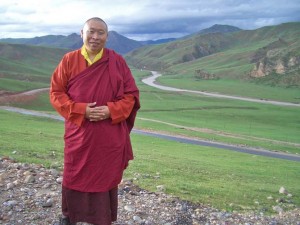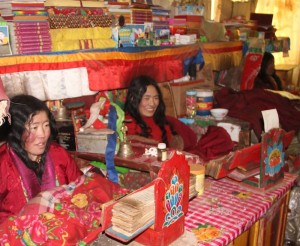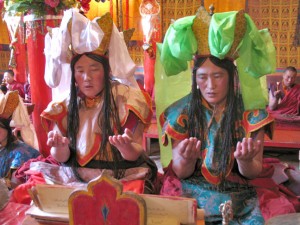- About Gebchak Gonpa – an overview.
Wangdrak Rinpoche talks about the Gebchak system and the importance of the feminine:
At the time Gebchak Gonpa was founded [in 1892] there were quite a few monasteries for monks, but no nunneries existed for women to practice Dharma. So the first Tsangyang Gyamtso built Gebchak Gonpa. His root lama was the first Tsoknyi Rinpoche.
Tsangyang Gyamtso, Tsoknyi Rinpoche, Wangdrak Rinpoche, Ngaksam Rinpoche… there were several masters in the early days who helped to establish the practice tradition of Gebchak Gonpa. They built Gebchak Gonpa because in having Buddha Nature, there is no difference whatsoever between male and female. Buddha Nature is equally present in everyone, and whoever practices the path can reach enlightenment – all male and females are exactly the same in this.
Despite this, however, conditions didn’t exist back then for females to practice Buddhism; their rights and opportunities were not equal to those of monks. So out of compassion, love, and a great need, Gebchak Gonpa was built specially for women to practise. Many nuns came to join and at its height, in the late 1950’s, there were over seven hundred nuns in Gebchak Gonpa. There are many stories from those days of great nuns who gained accomplishment and enlightenment, and the Nunnery became renowned throughout Tibet.
Then from around 1956 to 1981 some events occurred and Gebchak Gonpa was emptied. In 1981, when religion resurfaced, the old nuns returned and began to rebuild and reestablish Gebchak Gonpa and its tradition – and today there are 340 nuns.

The 16 retreat divisions building.
Today the Nunnery’s practice system and traditions are exactly the same as they were in the beginning; they haven’t degenerated or been changed at all. There are two three-year retreat centres, followed by entry into one of 16 retreat divisions. At Gebchak Gonpa they do intensive meditation and yoga practice. They spend their entire time practicing; they don’t engage in critical study, comparing texts, or various outside activities.
In Tibet Gebchak is still regarded as a unique, outstanding nunnery. How will it be in the future? I don’t know. Times are really changing and it’s something that concerns and worries me. For now, though, it is still very good.
As well, in the area surrounding the Nunnery the nuns are a great help to many people. How so? When you dedicate yourself to deep Dharma practice you can truly realize the Buddha Nature, and through that comes extraordinary compassion, love, and an open mind. With these qualities the nuns have a strong motivation to benefit others. They’re able to give counsel and insight and genuinely help a lot of people.
I believe that even globally there is great benefit from doing such genuine meditation and dedicated retreat.
Because these days in society there’s so much progress in technology and resources, and with that come a lot of distractions. People can never find enough time to stop and do meditation practice and retreat. People need to work full-time in order to make a living, and they have very little free time. At Gebchak Gonpa there are no phones, no TVs, no computers, etc. The nuns stay their whole lives in meditation practice and they realize extraordinary qualities of the mind, just like Milarepa – the great Tibetan yogi. So it’s very important.
These days in the world there are many forms of spirituality and many people who teach about them, but a lot of it is mere talk. People who actually practice and realize the essence of being, the Buddha Nature, are very rare. Because nobody has time, right?
At Gebchak Gonpa … they can realize the originally pure Buddha Nature of mind. With this realization comes a joy and strength of mind, which in turn inspires others to do the same.
They realize clearly how everybody wants to be happy, nobody wants to suffer; they have a profound motivation in their mind-stream to help others and they pray for all beings in the world to have peace and well-being. The nuns make sincere prayers for world peace.
I believe the nuns’ prayers are truly effective, because of the mind they pray with. At Gebchak Gonpa last year a few nuns passed away. As they were dying they were thinking, “My whole life I’ve meditated and practiced Dharma. I know the nature of my mind. I’m not afraid of dying.” They have confidence and even joy when they die!
Likewise some doctors came and told these nuns they would die in two or three days, but they had the mental strength to stay vibrant and live longer. Like this, extraordinary qualities develop if you’re really able to do genuine practice.
If you respect Gebchak Gonpa as a unique place where the nuns have such rare conditions for practice, please pray that it may be preserved in the future as well.
I have the hope that Gebchak Gonpa’s traditions can continue to be upheld like they were in the beginning. Nowadays, though, material conditions are rapidly developing everywhere. There are more things to see, to compare, more things to want . . .But I have the aspiration and the resolve to preserve Gebchak’s traditions as much as I’m able to.
The main thing – whether within religious practice or not – is to have love and care and to try to help others. In helping others it’s necessary to have some kind of potential and confidence. That confidence comes from knowing the true nature of your own mind, the pure Buddha nature. We need to know that we have it! If we can realize this Buddha nature we will have uncommon courage and strength of mind to accomplish vast benefit for others. We can work and be of great benefit to others.
Moreover, at Gebchak Gonpa the lineage of practice is a female lineage.
For example, the protectors include Ekadzati and Palden Lhamo [female protectresses]. Personal ‘yidam’ deities practiced are Arya Tara and Vajravarahi [female buddhas]. And when it comes to the yoga practices they are from an entirely female lineage practice, uniquely adapted for the female body in texts composed by the founding lama of Gebchak, Tsangyang Gyamtso. The nuns are still thoroughly upholding this lineage; it’s not been lost or mixed at all.
Before people thought that men had higher status than women, and that if males did Buddhist practice they would reach a higher level than females. There were no practice opportunities provided for females.
But now that’s not the case at all; there are unique practices for women. For example, the most essential practice teaching in Tibetan Buddhism is the Khandro Nyingtik, a female lineage that means “The Heart Essence of the Dakinis” – a teaching given directly from the dakinis [female embodiment of enlightened energy]. We should all know this – what the meaning is of female lineage.
It’s explained according to the earth element in the following verse,
“The female is like the earth, like the elements;
Like the earth, it is the basis for all qualities.”
The verse likens the female body to the earth. Being like the earth, if we have a good relationship with the earth and a good relationship with the feminine, there will be peace and balance in the world. Diseases, famine, epidemics, fighting… there isn’t peace in the world now because the earth elements are disrupted and the earth goddesses displeased. They mainly come about due to this imbalance, don’t they?
In Tibet we believe in female spirits like dakinis, earth goddesses and so forth. We believe that if we’ve disturbed or aggravated them, we must confess and do purification ceremonies to appease them. We perform confession and feast offerings, and when the dakinis are pleased the environment is peaceful. Prayers that we make to the dakinis have a special power to come true. The dakinis have also made prophecies about these things in their symbolic language.
At Gebchak Gonpa the yoga practices are from a female lineage, which bring closer, more direct accomplishment for women. There are such unique qualities of the feminine and a female lineage of practice.
My prayer is to preserve and protect this female lineage of Gebchak Gonpa. My request to people throughout the world is to pray for the Gebchak lineage to be entirely preserved in the future.
Recorded on October 24, 2010 at Xining, Qinghai (gateway city to Nangchen, Tibet).
- Back to About Gebchak.
- Read excerpts from “Chapter 16: The Nunnery of Yoginis” In Blazing Splendor: The Memoirs of the Dzogchen Yogi Tulku Urgyen Rinpoche.




